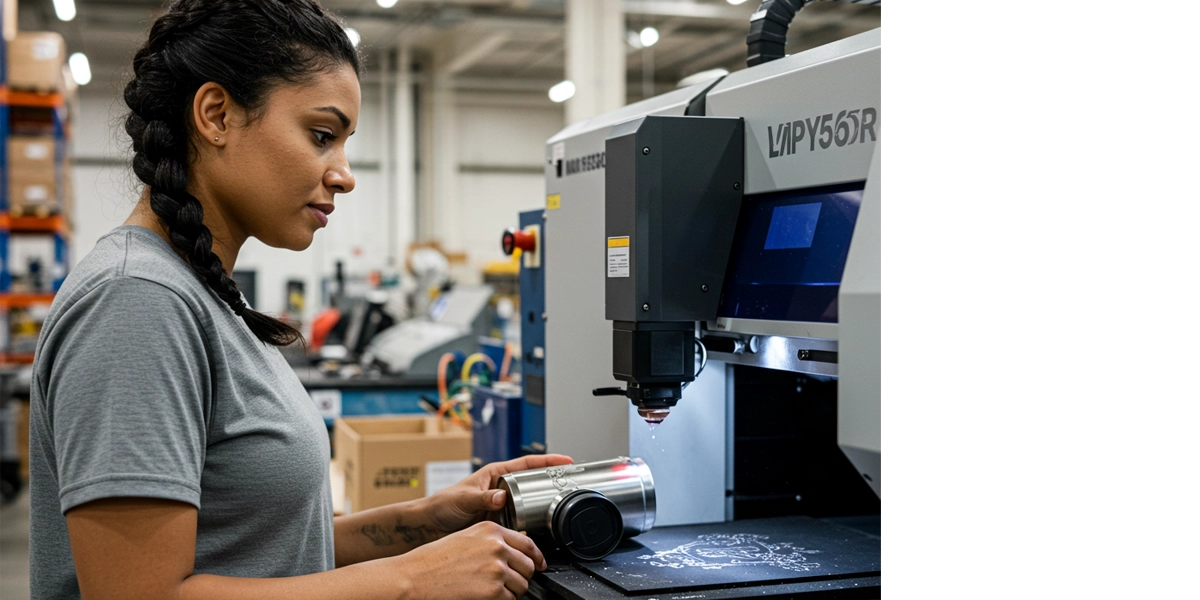In This Article:
Artificial intelligence (AI) is revolutionizing the logistics industry, transforming supply chain management and transportation. This transformation promises enhanced efficiency, predictive capabilities, and real-time visibility. Machine learning in logistics helps businesses optimize operations, reduce costs, and improve customer satisfaction.
AI technologies are being integrated across various logistics functions:
- Predictive analytics: Enhancing demand forecasting with machine learning.
- Automation: Streamlining warehouse management through robotics.
- Real-time tracking: Combining AI with IoT for shipment visibility.
From advanced warehouse automation to inventory management alerts, OWD is continuously using new tools to help ecommerce brands stay competitive in a rapidly evolving industry. To further enhance your logistics operations, OWD offers a range of services to improve the fulfillment experience, such as call center services, to take care of customer questions via email, chat, and phone.
By embracing AI technologies, logistics companies can navigate complexities, anticipate challenges, and deliver exceptional service. Let’s explore how AI is reshaping the logistics industry and in the meantime, check out our guides on custom packaging in ecommerce, sustainable and eco-friendly fulfillment, and ecommerce customer service best practices, to learn valuable insights to optimize your ecommerce operations.
1. Transforming Warehouse Management with AI
AI technologies are revolutionizing warehouse management by incorporating robotics and automation into logistics operations. These AI advancements in warehouse management have enabled businesses to streamline various processes, resulting in significant improvements in efficiency and accuracy.
Robotics and Automation: The New Norm
Robotics in logistics have become indispensable. They automate repetitive tasks, such as picking, packing, and sorting, which reduces human error. Autonomous mobile robots (AMRs) navigate warehouse floors, transporting goods to different locations. This seamless integration of robotics minimizes downtime and accelerates order fulfillment.
Benefits of AI in Warehouse Management
Implementing artificial intelligence in warehouse operations offers numerous benefits:
- Enhanced Efficiency: AI systems optimize route planning and resource allocation. This results in faster processing times and reduced operational costs.
- Improved Inventory Accuracy: AI-driven inventory management uses real-time data to monitor stock levels and predict demand. It significantly reduces the chances of overstocking or stockouts.
- Cost Savings: Automation decreases labor costs while increasing throughput. Over time, this leads to substantial financial savings for businesses.
Real-World Examples
Several companies have successfully leveraged AI to transform their warehouse operations:
- Amazon: Known for its cutting-edge technology, Amazon employs thousands of Kiva robots to streamline its warehousing processes. These robots handle tasks like picking items from shelves and transporting them across the warehouse.
- Walmart: Utilizing AI for inventory management, Walmart has implemented Bossa Nova robots that scan shelves for out-of-stock items or pricing errors. This ensures optimal inventory levels and enhances customer satisfaction.
Addressing Challenges in AI-Driven Warehouse Management
While implementing AI-driven solutions in warehouse management is highly beneficial, it’s important to address the challenges associated with it. Inventory management remains a critical aspect of an optimal ecommerce business. From demand forecasting to stock optimization, businesses must overcome these hurdles to fully capitalize on the advantages of AI.
Key Challenges in AI-Driven Inventory Management
- Demand Forecasting: Accurate demand forecasting is essential for maintaining optimal inventory levels. However, it can be challenging due to fluctuating market trends and consumer behaviors. Businesses need robust AI algorithms capable of analyzing vast amounts of data to predict future demand accurately.
- Stock Optimization: Achieving the perfect balance between overstocking and understocking is another significant challenge. Overstocking ties up capital and increases storage costs, while understocking leads to missed sales opportunities and dissatisfied customers. AI can assist by providing real-time insights and recommendations for optimal stock levels.
- Data Integration: For AI systems to function effectively, they require seamless integration with existing ERP (Enterprise Resource Planning) and WMS (Warehouse Management Systems). This often involves complex data migration processes and ensuring data consistency across platforms.
- Cost Implications: The initial investment in AI technology can be substantial. Businesses must consider not only the cost of acquiring AI tools but also the expenses related to training staff and maintaining the system over time.
AI-Driven Warehouse Management Solutions
Using AI warehouse management solutions can help address these challenges. By leveraging AI algorithms, these solutions can analyze historical sales data, market trends, and external factors to generate accurate demand forecasts. This enables businesses to optimize their inventory levels, reducing both overstocking and understocking.
Best of all, AI-powered warehouse management systems can seamlessly integrate with existing ERP and WMS platforms. This ensures smooth data flow between different systems, eliminating the need for manual data entry and reducing the risk of errors.
While the initial investment in AI technology may be significant, the long-term benefits often outweigh the costs. Improved inventory management leads to cost savings by minimizing storage expenses and reducing stock write-offs due to obsolescence.
In addition, AI-driven warehouse management systems can enhance operational efficiency by automating routine tasks such as order fulfillment and inventory replenishment. This frees up staff time for more value-added activities, ultimately driving productivity and customer satisfaction.
Overall, adopting AI in warehouse management is crucial for businesses looking to stay competitive in today’s complex and dynamic market. The benefits of improved demand forecasting, optimized inventory levels, streamlined operations, and enhanced customer service make the investment worthwhile.
Problems with Online Shopping
In addition to enhancing warehouse management, AI can also address some of the problems with online shopping. By leveraging AI technologies like chatbots and recommendation engines, businesses can provide personalized experiences, mitigate issues such as lack of product information or overwhelming choices, and ultimately improve customer satisfaction.
These innovations exemplify the transformative power of AI technologies, positioning businesses at the forefront of modern warehouse management practices.
2. Optimizing Supply Chain Efficiency through AI-Powered Predictions
Predictive analytics and machine learning algorithms are transforming demand forecasting and planning in the supply chain. These advanced technologies provide valuable insights into future demand trends, enabling more accurate and efficient decision-making.
Enhancing Demand Forecasting
Machine learning models analyze large amounts of historical data to predict future demand with great accuracy. These algorithms take into account various factors such as seasonal trends, market conditions, and consumer behavior to generate forecasts that are more reliable than traditional methods.
Example: Retail giants like Walmart use predictive analytics to optimize inventory levels, ensuring that products are neither overstocked nor understocked. This leads to reduced carrying costs and minimized stockouts.
Identifying Potential Bottlenecks
AI’s ability to analyze demand patterns helps in identifying potential issues before they disrupt the supply chain. By monitoring key metrics in real-time, AI systems can alert managers to problems such as delays in shipment or production slowdowns, allowing for timely interventions.
Example: Amazon uses machine learning to continuously monitor its logistics network, identifying and addressing issues before they become major challenges.
Proactive Business Decisions
Using AI-generated insights empowers businesses to make informed, proactive decisions. Whether it’s adjusting procurement schedules, optimizing transportation routes, or reallocating resources, AI provides the data-driven basis for strategic planning.
Example: Companies like Procter & Gamble utilize predictive analytics to streamline their supply chains, resulting in improved efficiency and cost savings.
3. Enabling Real-Time Tracking and Visibility with AIoT
Visibility in logistics operations is crucial for maintaining smooth and efficient processes. Real-time tracking, made possible by combining Artificial Intelligence (AI) and the Internet of Things (IoT), offers unmatched insight into the movement of shipments. This powerful combination, known as AIoT, is revolutionizing traditional logistics through the integration of smart sensors and advanced analytics.
The Significance of Real-Time Data Visibility
Real-time data visibility ensures that you can monitor every aspect of the logistics chain as it happens. This capability minimizes delays, prevents losses, and enhances decision-making processes. Here’s why it matters:
1. Immediate response to disruptions
Access to real-time data allows logistics managers to react promptly to unforeseen events such as traffic jams or mechanical failures.
2. Enhanced inventory management
Continuous monitoring of stock levels helps avoid shortages or overstock situations.
3. Improved route optimization
Real-time updates on road conditions mean that delivery routes can be adjusted on-the-fly for maximum efficiency.
How AIoT Makes Real-Time Tracking Possible
AIoT combines AI algorithms with IoT devices to create a network of connected sensors that collect and analyze data in real time. Here’s the step-by-step process:
- Smart Sensors: These devices are embedded in shipments and vehicles, gathering data on location, temperature, humidity, and other critical factors.
- Data Transmission: Information is continuously sent to a central system through wireless networks.
- AI Algorithms: Advanced machine learning processes this influx of data to predict potential issues and optimize routes.
- User Interface: Logistics managers receive actionable insights via dashboards and alerts.
This seamless integration significantly improves operational transparency.
The Benefits of AIoT for Customers
Transparency doesn’t just benefit internal operations; it also has a significant impact on customer satisfaction:
- Accurate ETAs: Customers receive a precise estimated time of arrival notifications, reducing anxiety over delivery times.
- Detailed Tracking Information: Clients can track their packages in real-time, fostering trust and loyalty from the first to the last mile of delivery.
- Proactive Issue Resolution: Immediate alerts about delays or issues ensure customers are always informed about their order status.
With these advantages, AIoT not only streamlines logistics operations but also enhances the customer experience.
4. The Future is Here: Autonomous Vehicles and Delivery Drones
The logistics industry is undergoing a transformation with the advent of autonomous vehicles and delivery drones. These technological advancements are revolutionizing the way we transport goods, making it more efficient and safe.
Autonomous vehicles such as self-driving trucks and vans utilize advanced AI algorithms to navigate roads, optimize routes, and minimize human errors. These vehicles bring numerous benefits to ecommerce businesses, including:
- Increased Efficiency: Unlike human drivers, autonomous vehicles can operate continuously without breaks, resulting in faster deliveries.
- Enhanced Safety: With AI systems constantly monitoring the surroundings for potential hazards, the chances of accidents significantly decrease.
- Cost Savings: Smarter driving decisions by autonomous vehicles translate into reduced labor and fuel expenses.
On the other hand, using drones for short-distance delivery introduces a new dimension to logistics operations. These unmanned flying machines offer several advantages:
- Speed: By bypassing traffic congestion, drones can swiftly transport packages to their destinations.
- Accessibility: Drones are particularly useful for delivering to remote or hard-to-reach areas.
- Environmental Benefits: Electric drones contribute to reducing carbon emissions, thus helping mitigate our environmental impact and more sustainable fulfillment.
However, there are challenges associated with drone deliveries that need to be addressed:
- Regulatory Hurdles: Establishing clear guidelines for operating drones in certain areas is an intricate task that requires careful consideration.
- Weight Limits: Currently, drone technology is limited to effectively handling only small packages.
Despite these challenges, the logistics industry’s future looks promising for both autonomous vehicles and delivery drones. As regulations evolve and technology advances further, these innovations will likely become integral components of our supply chain. Businesses that embrace these emerging trends will gain a competitive advantage.
Addressing Cybersecurity and Privacy Challenges in an AI-Powered Logistics Landscape
The integration of AI systems into logistics brings a new level of efficiency and precision. However, it also introduces significant cybersecurity risks. The reliance on interconnected networks and vast amounts of data makes the supply chain ecosystem a prime target for cyberattacks. Threats such as data breaches, ransomware, and hacking can compromise sensitive logistics operations, leading to severe disruptions.
Key Cybersecurity Concerns:
- Data Breaches: Unauthorized access to confidential information can result in financial losses and damage to your brand reputation.
- Ransomware Attacks: Malicious software that encrypts critical data until a ransom is paid can halt logistics operations.
- Hacking: Intrusions into network systems can manipulate or steal data, impacting the accuracy of AI-driven decisions.
Ensuring Data Privacy and Mitigating Cyber Threats
To safeguard against these cybersecurity risks, implementing robust security measures is essential. Ensuring data privacy and mitigating cyber threats in an interconnected supply chain ecosystem requires a multi-faceted approach:
- Encryption: Encrypt all sensitive data both in transit and at rest. This ensures that even if data is intercepted, it remains unreadable without the appropriate decryption keys.
- Regular Security Audits: Conduct frequent security audits to identify vulnerabilities within your AI systems. Regular assessments help in promptly addressing potential security gaps.
- Access Control Mechanisms: Implement stringent access control mechanisms. Limit system access to authorized personnel only, reducing the risk of internal threats.
- AI-Powered Threat Detection: Leverage AI itself to detect anomalies and potential threats in real time. AI-driven threat detection systems can analyze patterns and flag suspicious activities before they escalate.
- Employee Training: Educate your workforce about cybersecurity best practices. Awareness training helps employees recognize phishing attempts and other common cyber threats.
Access the Most Advanced B2B and D2C Fulfillment Solutions with OWD
AI is revolutionizing the logistics industry, making supply chain management more efficient and precise than ever before. To stay competitive, it’s crucial to embrace these advancements. From automating warehouses to providing real-time shipment tracking, AI-powered solutions are completely transforming how logistics companies operate.
Here are some key benefits of integrating AI into your supply chain:
- Enhance operational efficiency: Utilize predictive analytics to streamline processes and make better decisions.
- Improve inventory accuracy: Implement robotics and automation technologies to manage stock more effectively.
- Increase transparency: Provide customers with live tracking updates to improve their satisfaction.
If you’re struggling to optimize your fulfillment operation, schedule a call with one of our logistics experts. We’ll take a look at your current approach and discuss ways to reduce logistics costs while improving fulfillment times and the overall experience. Take advantage of our advanced tech stack that optimizes our clients’ ecommerce operations front to back for superior performance and profitability.
You can also use our personalized-to-consumer (P2C) fulfillment services so your shoppers can start personalizing products with custom engraving and embroidery to help boost profits and word-of-mouth promotion. Fill out this form to book a time!
In This Article:
Subscribe to our Newsletter
Tincidunt urna mauris eu quam vulputate lobortis sit. Purus feugiat arcu nunc quisque massa ut.



























